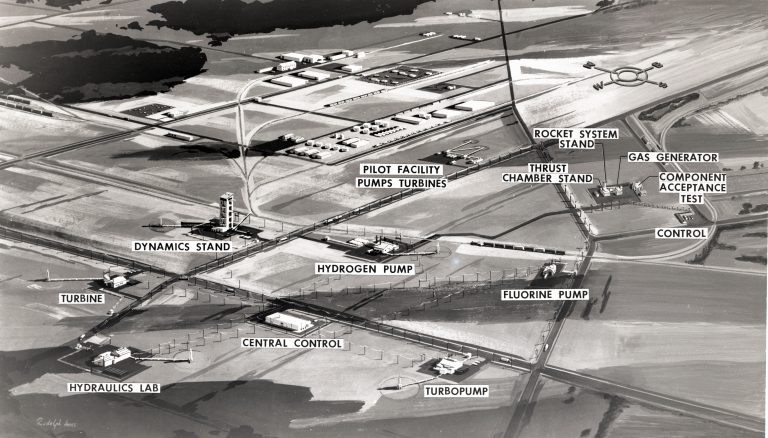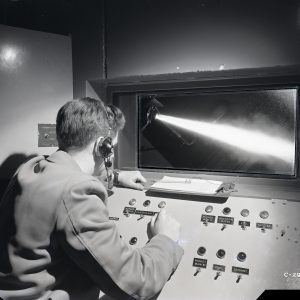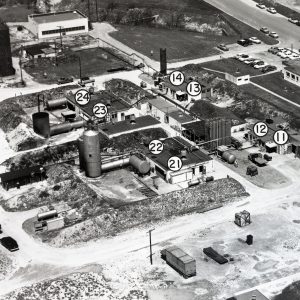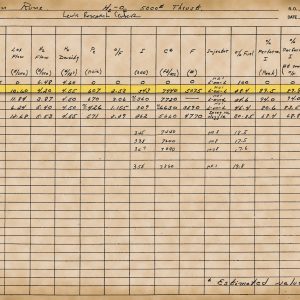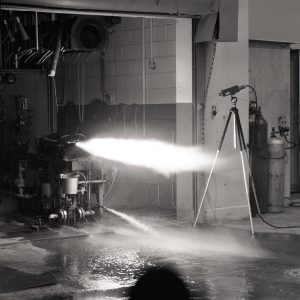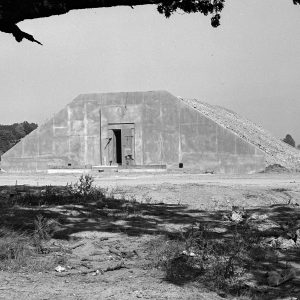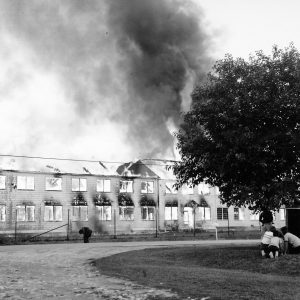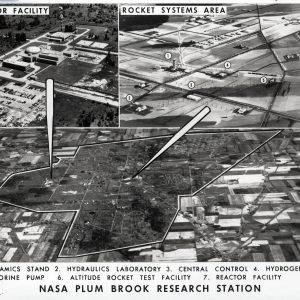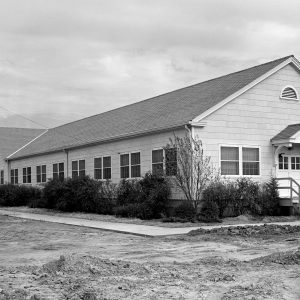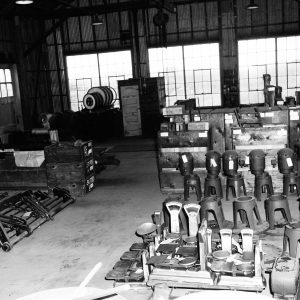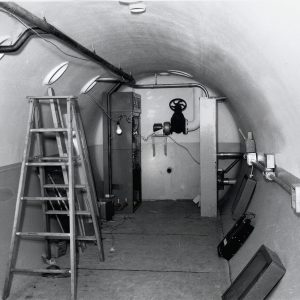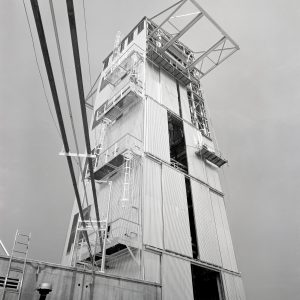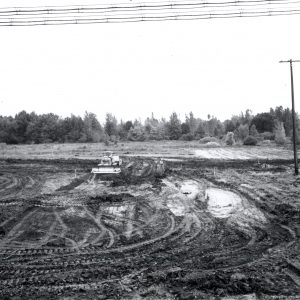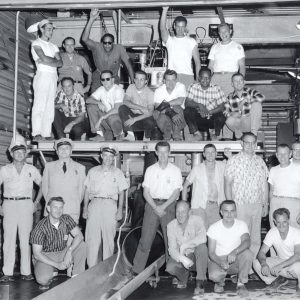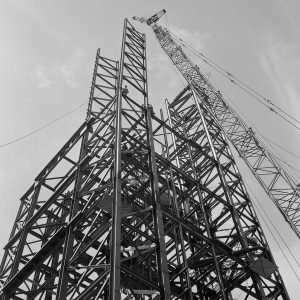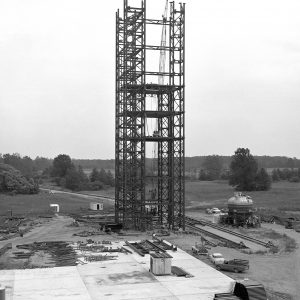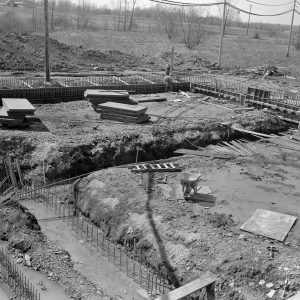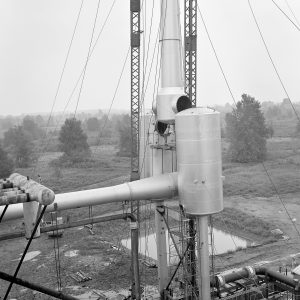Design and Construction
The NASA Lewis Research Center (known today as the Glenn Research Center) began experimenting with high-energy propellants in the mid-1940s. After comparing the performance and handling difficulties of many fuels, researchers determined that liquid hydrogen was the optimal propellant. In the late 1950s, the center began planning a suite of new facilities referred to as the Rocket Systems Area to expand its high-energy propellant test capabilities. To mitigate the danger of testing these propellants at the center, NASA built its new test sites at the sprawling Plum Brook Ordnance Works (PBOW) in Sandusky, Ohio. The majority of the Rocket Systems Area sites became operational in 1961.
The Rocket Systems Area contained the Liquid Hydrogen Pump Facility (A Site), the Turbopump Facility (C Site), the Controls and Turbine Test Facility (D Site), the Hydraulics Laboratory (F Site), the Pump and Turbine Facility (Pilot Plant or G Site), the Fluorine Pump Facility (I Site), the Rocket Systems Test Laboratory (J Site), and the Cryogenic Propellant Tank Facility (K Site). The Rocket Systems Area also included three test stands: the Dynamics Stand (E Stand), the High Energy Rocket Engine Research Facility (B–1), and the Nuclear Rocket Dynamics and Control Facility (B–3).
NACA Hydrogen Research
Early rocket scientists Konstantin Tsiolkovsky and Robert Goddard foresaw the benefits of using liquid hydrogen to fuel rocket engines. Hydrogen, however, which must be kept at –423 °F to retain its liquid form, was difficult to manufacture and even more difficult to handle. After the success of the German’s liquid-kerosene-fueled V—2 rocket during World War II, the U.S. military became interested in developing missile technology. The military also sponsored studies of liquid hydrogen as a fuel at the Ohio State University, the Jet Propulsion Laboratory, and Aerojet. Despite some promising results, the military’s interest waned by 1950. It was at this time that Lewis researchers began increasing their studies of high-energy propellants.
In 1941 the National Advisory Committee for Aeronautics (NACA) established the Aircraft Engine Research Laboratory (the future Lewis and Glenn Research Centers) in Cleveland, Ohio. It was the NACA’s third research laboratory and the only one dedicated to engines. By the mid-1940s the lab focused its energy on the new turbojet, ramjet, and rocket technologies that emerged during World War II. Researchers in the rocket field concentrated on the study of high-energy propellants and engine cooling.
The lab built a small collection of outdoor test cells, known as the Rocket Lab, to facilitate the studies. The researchers first examined propellants with extremely high theoretical values such as diborane and hydrazine. These performed much better than traditional rocket fuels, but were very toxic and difficult to handle. In the early 1950s Lewis researchers began focusing on liquid hydrogen. In 1954, they successfully burned gaseous hydrogen in a turbojet combustor and fired a small liquid-hydrogen/liquid-oxygen rocket engine. These early studies demonstrated hydrogen’s capabilities and led to further development.
Documents
- Liquid Hydrogen as Jet Fuel for High-Altitude Aircraft
- Liquid Hydrogen as a Propulsion Fuel, 1945–1959
- “Seizing the Space Initiative”
Plum Brook Station
In early 1941 the U.S. Government seized roughly 9000 acres of farmland near Sandusky, Ohio, to construct the PBOW. This fenced-in industrial complex produced trinitrotoluene (TNT), dinitrotoluene (DNT), and pentolite powder for shells during World War II. The PBOW ceased production immediately after the war and remained vacant for 10 years. In 1955 the NACA leased 500 acres at the PBOW to build a nuclear test reactor.
With the advent of the space program, the NACA became a part of the new National Aeronautics and Space Administration (NASA) in 1958. The new agency leased an additional 2725 acres at Plum Brook to build a series of rocket test facilities known as the Rocket Systems Area. NASA also began planning other facilities. PBOW was officially renamed Plum Brook Station in February 1962. On March 15, 1963, Lewis officially took control of the 500 acres leased for the reactor, the 2725 acres leased for the Rocket Systems Area, and the remaining 2800 acres. NASA decided to raze the unwanted PBOW structures at this time. The center continues to use Plum Brook, which was renamed the Neil Armstrong Test Facility in 2021, for remote testing today.
Documents
- Saga of the PBOW (1945)
- NACA Construction House Bill (1957)
- Evaluation of the PBOW (1958)
- Acquisition of Additional Plum Brook Property (1958)
- Science in Flux: NASA’s Nuclear Program at Plum Brook
Design and Construction
Lewis engineers began designing the new Rocket Systems Area facilities in the fall of 1957. They based several of the facilities on smaller rigs previously built at Lewis. Construction crews began preparing the new test sites in the fall of 1958, and many of the buildings were in place in the following spring. The installation of the infrastructure, test equipment, data systems, and other components required years of additional work, however. The facilities then went through months or years of checkout runs to verify that the equipment functioned properly.
Engineers incorporated PBOW equipment into the design of the Pilot Plant (G Site) to expedite the construction. In December 1958, it became the first facility to be completed. E Stand, C Site, and several of the rigs at J Site began operating in the summer of 1961. I Site, A Site, and J–4 went online in the spring of 1962, and F Site began its checkouts in April 1963. Excavations for the B-1 test stand’s foundation began in early 1960, and the structure is visible in photographs from later that year. In the summer of 1961, NASA Lewis management decided to alter the B-1 design specifically to handle turbopump testing of a NERVA nuclear engine. It took several years to make the modifications and integrate the NERVA engine and its instrumentation into the test stand. The first official test runs were in August 1964.
Lewis engineers began planning a new wave of larger, more sophisticated facilities shortly after President Kennedy’s famous “Urgent National Needs” speech in late May 1961 which not only called for the lunar landings, but also advocated an increased nuclear rocket program. The B-3 test stand, K Site, and HHTF were added to the Rocket Systems Area in the mid-1960s and work began on two even larger facilities– the Spacecraft Propulsion Research Facility (B–2) and the Space Power Facility (SPF).

